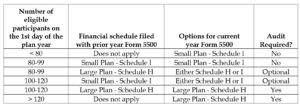Managing your retirement plan participant count is essential in determining whether there is an audit requirement. The audit requirement is determined based on the number of eligible participants reported on the Form 5500 filing as of the beginning of the plan year.
The definition of an eligible participant includes:
- Current employees who are deferring and/or receiving contributions
- Current employees who are eligible to participate in the plan but elect not to participate
- Terminated participants who still have an account balance in the plan
Generally, plans with 100 or more eligible participants are categorized as large plans and are required to attach audited financial statements to their Form 5500 filing. However, the 100-participant threshold is only applicable for plans in their initial year of existence. Plans that have existed for more than one year are subject to certain exceptions, commonly referred to as the 80-120 rule.
The table below illustrates the various requirements based on the number of eligible participants at the beginning of the year:

Plans that have over 120 eligible participants at the beginning of the plan year automatically have the audit requirement with no applicable exceptions. Plans with fewer than 100 participants are exempt from the audit requirement, unless the plan trustee requests an audit. If a plan exceeded 120 participants in the prior year, but currently has between 100-120 eligible participants, an audit would be required until the eligible participant count falls below 100. On the contrary, if the number of eligible participants was under 100 in the prior year, an audit would not be required until the number of eligible participants exceeds 120.
January 1, 2023 is fast approaching and with it the annual audit determination. If the number of eligible participants in your plan is approaching or near these thresholds, here are a few steps you should follow:
- Understand the plan cash out provisions to determine whether there are separated participants with balances below the threshold that can be distributed prior to year-end
- Review the eligible participant detail for accuracy and identify the audit requirement as soon as possible to engage an audit firm to properly plan and perform the audit
- Communicate staffing expectations during the year to avoid surprises related to an audit
Plan sponsors often need assistance with determining the eligible participant count and whether an audit is required. By working with both your plan recordkeeper and your audit firm, you can identify audit requirements in a timely manner and avoid the potential problems with the DOL down the line.
Nicholas W. Ward can be reached at Email or 215.441.4600.
You may also like:

